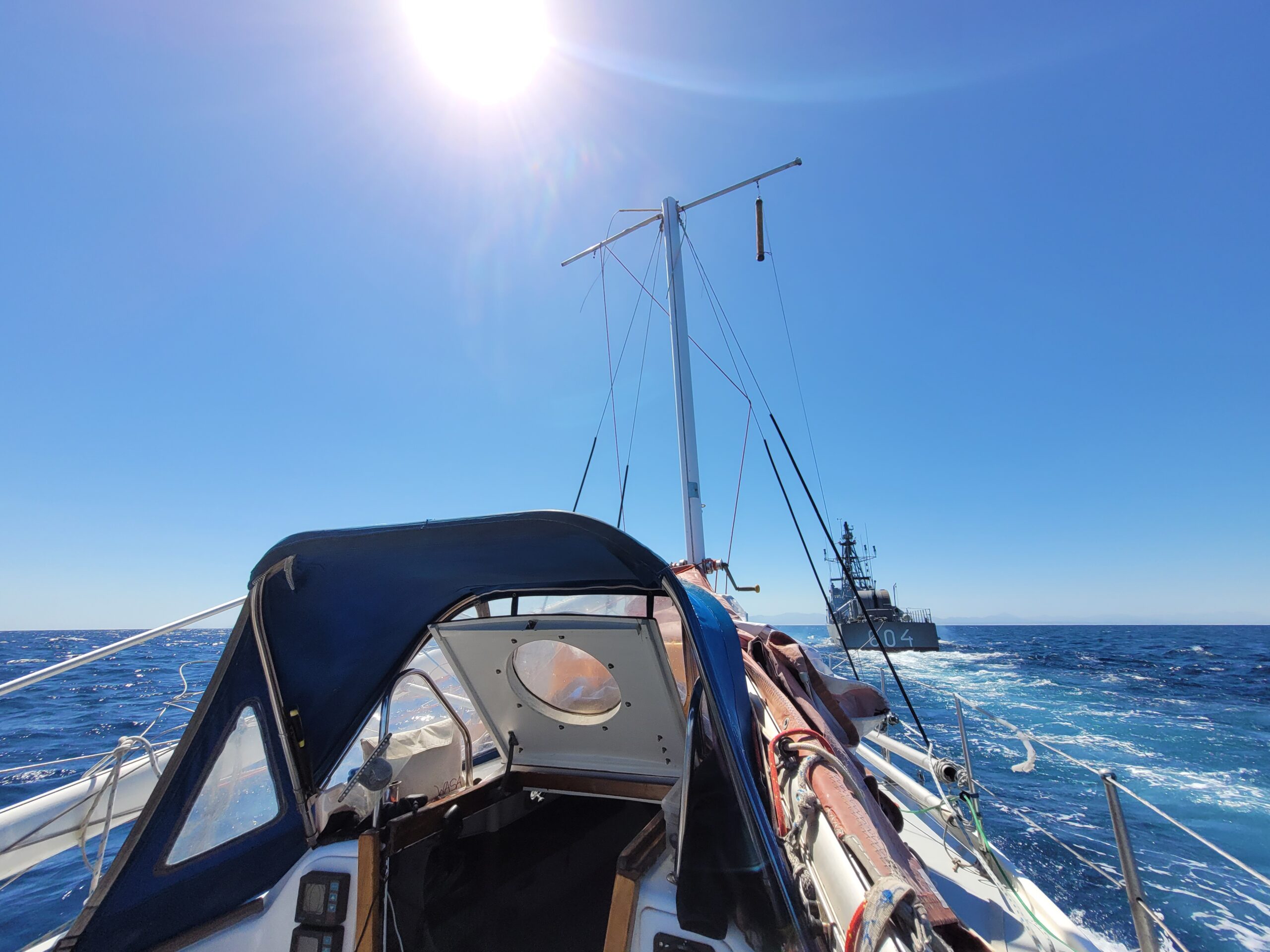
The month and a half since I left the Maldives feels like a movie: pirates, explosions, rockets and air strikes. In one of the last scenes, my mast breaks.
I know there’s been building quite a gap in my blog! Since my arrival on Lombock in November, I have already left several thousand nautical miles in my wake. We visited Indonesia, Malaysia, Singapore, the Maldives and Djibouti.
There have been no more new articles, not because I don’t feel like it – no, funnily enough, I often felt a great desire to put what I’ve experienced into a text. But I couldn’t manage it. There was and is simply too much to do! We spent a lot of time at sea. The stays ashore were short and often very tedious. I’ll catch up on that, but for now this post has to be here! Too much happened; the impressions were too intense:
When I left Male (on February 16) for Djibouti, I thought I knew what to expect. I knew about the potential danger of pirate attacks, or attacks by the Huthi militia. For months, I had been observing events in the region, analyzing attacks on other ships (mostly commercial shipping) and assessing developments together with other sailors.
I had studied the reports from the UKMTO (United Kingdom Maritime Trade Organization) and the recommendations from the MSCHOA (Maritime Security Center Horn of Africa). I concluded that the risk for me as a small private sailor of being robbed or shot down by $100,000 missiles was low. A detour around the Cape of Good Hope also harbors dangers and would have cost me a good year more time. – I wanted to dare to sail through the Gulf of Aden & the Red Sea!
A good friend who wanted to accompany me on the first part to Djibouti unfortunately had to get surgery shortly before her plane left. (luckily, she’s fine again!!). Finding new fellow sailors in such short time turned out to be difficult given the route. So, I started alone.
The wind was rather weak for the entire crossing. I sailed at an average speed of just 3.1kts and needed over 24 days to cover the 1800 nautical miles! Sailing slowly wears (me) down. Especially on a crossing where you run the risk of being attacked. It would have been nice to sail a bit faster and not bob around the all-you-can-eat buffet on a platter.
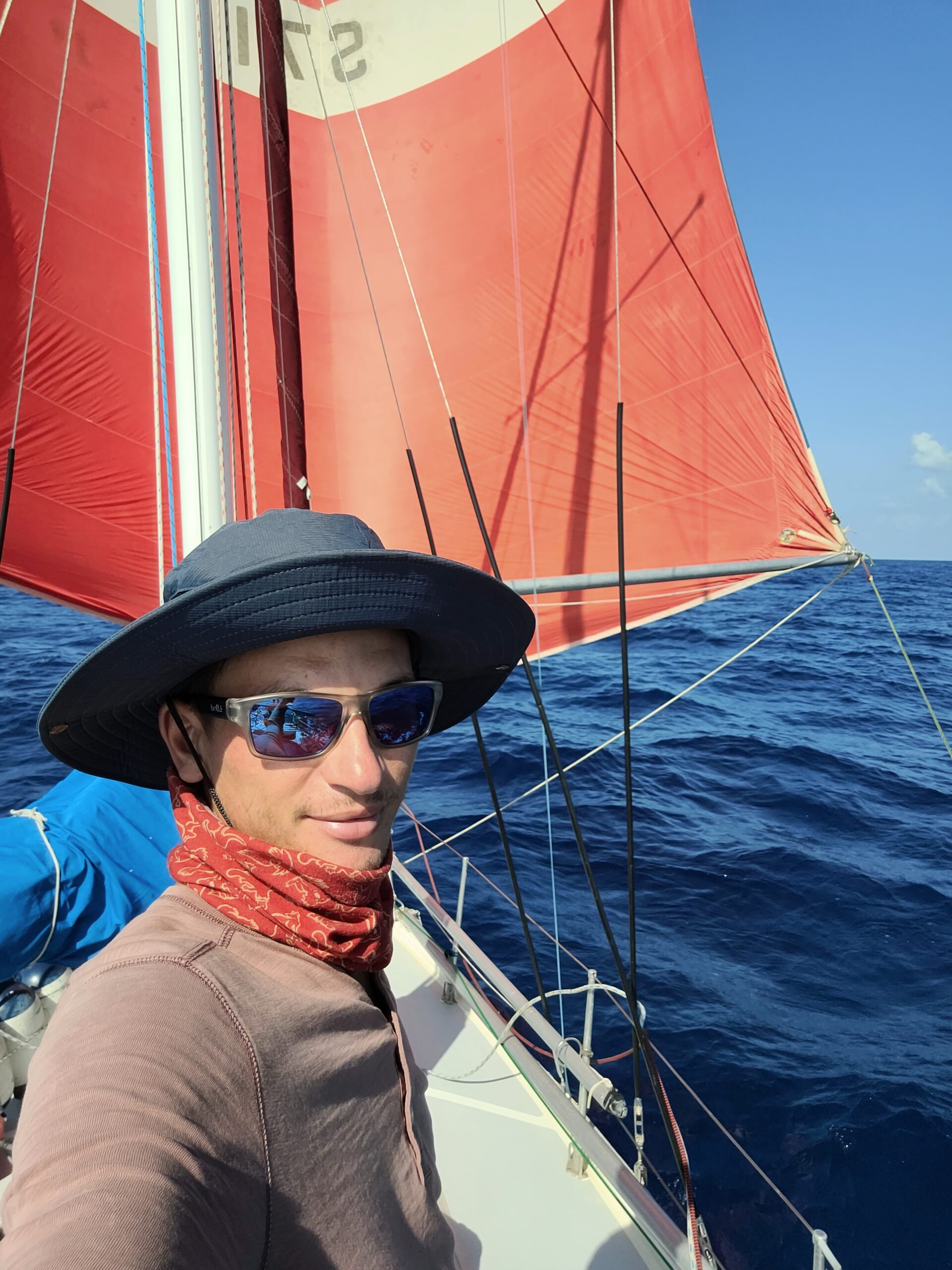
I set my AIS to silent mode to make myself a little less visible while approaching the safety corridor (IRTC = internationally recomended traffic corridor) in the Gulf of Aden. This meant I could see but not be seen by others. I also avoided using the radio at all costs, dismantled my radar reflector and only illuminated the position lights at deck level instead of the three-color lantern in the mast, which are visible from afar.
(I’ll leave out many of the additional challenges below: Garbage in windvane steering, broken autopilot, lack of sleep, torn sails, tantrums, broken alternator, etc. – It would otherwise go beyond the scope of the article even more than it already does).
If I couldn’t be seen, then I had to make sure that I could see others as best I could before we would come dangerously close. I made my bed out of camping mats and seat cushions in the cockpit and from then on I always slept under the stars. Always about one to two hours at a time, maximum. Depending on whether I suspected ships in the area or not.
When I wasn’t below deck or asleep, my eyes were glued to the horizon. Even though I told myself „Everything’ s fine“ and knew that the risk of being seen by pirates was low, I was subconsciously afraid. I kept reaching for the binoculars and doing my rounds.
I was already sailing in the high-risk zone; it was the tenth day at sea when a skiff suddenly appeared between the wave crests. „Where there’s one skiff, there’s usually at least one more! And most probably a mother ship too!„, it flashed through my mind! Fishermen use these boats to hunt for tuna. But pirates use the same, often hijacked boats to catch people, ships and money! And so, I watched. Watched through binoculars to see if anything would change at our distance.
It was only when I recognized a freighter appear on the AIS that I was able to calm down a little. I radioed him and asked him if he could see anything more due to his elevated position: „Yes Sir, I can see at least 2 motherships and about six speedboats. I think you can relax. This looks very much like regular tuna fishing.“
I hadn’t quite braced myself when I heard a roar next to the boat – the unmistakable sound of a skiff racing over wave crests! While I was still turning around, I thought: „That’s it! – Now I am really fucked!”
But not pirates paced towards me! A huge wall of dolphins, probably over 200 animals, raced towards me and WASA, jumping and obviously hunting. I had never seen anything like it! „What’s going on here? – That’s not normal.“.
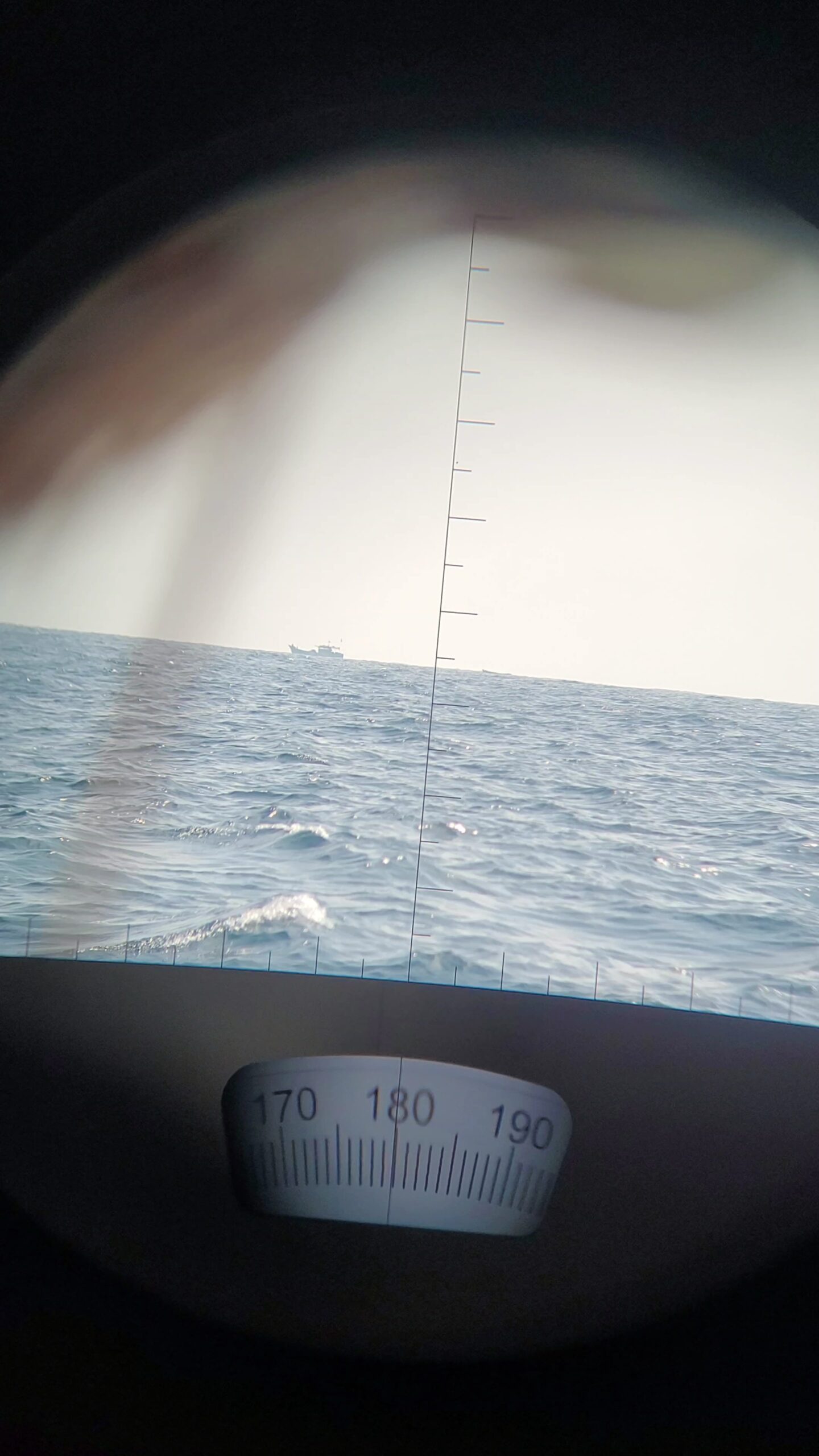
But the very next day, the experience was eclipsed. It was afternoon. Once again, I stared at the horizon for far too long. I was puzzled. „Was there just a pillar there?“; „Am I going crazy now or what?“.
Yes, there it was again. Quite clearly! I grabbed the binoculars and it wasn’t long before I had it right in front of me: an explosion! The binoculars brought it very close to my eye: first a white blast, then something like splashing water and finally a column of smoke that only slowly dissipated into thin air.
I was taken by surprise and didn’t really know what to do! At least I could tell that the detonations weren’t getting any closer! But I couldn’t see another ship for miles around, not even on the AIS. I counted around 20 explosions, which kept moving along the horizon.
I reported the incident to the UKMTO:
„SY WASA observed Explosions.0950 UTC at 13°08.639N 059°07.740E: I saw multiple explosions & smoke at a bearing of 335°, just under my visible horizon. Is there any military exercise in place? Best regards, Paul“
Response: „Good morning and thank you for your report. UKMTO will pass your information on, but we would not be made aware of any operations. Kind regards, UKMTO“
I didn’t really know if they believed me. Did I believe myself? – I no longer knew. But shortly afterwards I was confirmed by more explosions: It was real!
On the last day before my arrival in Djibouti – day 23 at sea, the radio buzzed again. But this time the message sounded very different from the usual bla bla bla: „Life raft sighted“, … „ship hit“, … „abandoned ship“… „Indian Warship, this is US coalition forces airplane. Do you have any updates?“, … „21 rescued, 2 crew & armed guard still missing.“.
“Shit! What’s that again? “- Just at that moment, an airplane flew low over my head.
I didn’t know what was going on. Once again, like all the time when something happened out here, I knew nothing! I’d been bobbing around in my own little bubble for 23 days and didn’t know what the hell was going on around me, or anywhere.
I didn’t even think of disturbing the radio traffic to ask questions! Someone had much better things to do than answer those. And the Navy knew I was there. If I could have been of any help, they would have contacted me.
I prepared myself for another restless night. By now, the experiences were really getting to me. And it didn’t get any better when, at around midnight, I received a message on my satellite phone from a reporter from the American ABC News: the True Confidence had sunk, apparently with fatalities, and I was the next ship at the scene of the accident. – Had I seen or heard anything?
Shit! Shit, again! The name! I had only heard it the night before! A ship with exactly that name was warned over the radio, for over an hour, again and again! By whoever.
The repetitive message had prevented me from falling asleep and at some point annoyed me so much that I even recorded it: „True Confidence[…], your request to proceed through Bab el Mandeb is prohibited! Captain, please change your course to another destination! Otherwise, you are responsible for all actions taken against your ship! [..]“
Instead of answering the reporter, I wrote to my dad. I had to know what was going on! But it was still too early. The news hadn’t even made it onto the internet yet. It wasn’t until much later the next day that my dad was able to pass the news on to me: A Freighter, the True Confidence was sunk by a Huthi missile. Three people dead. – it happened less than 10 nautical miles from my position.
When I arrived in Djibouti, I was immediately greeted by my friends! Boy, was I looking forward to finally being able to talk to someone, to hug someone! But we quickly got down to business: A weather window opened up. On Sunday there was perfect wind for the passage of Bab el Mandeb. Everyone was going! Around ten boats were waiting here, and I knew most of them.
Under no circumstances would I miss the window and sit here alone, not knowing when the next one would open. I had two, or rather two and a half days to get ready to leave again! Half a day was spent clearing in; and drinking beer. – Until late into the night. So there were only two days left to replace the alternator, repair the windvane, clean the boat, do the laundry, fill up with water, refuel with diesel, go shopping, withdraw money and clear out. This would never have been possible without the help of my agent! (Nothing works here without an agent) – Big thanks Mohammed!
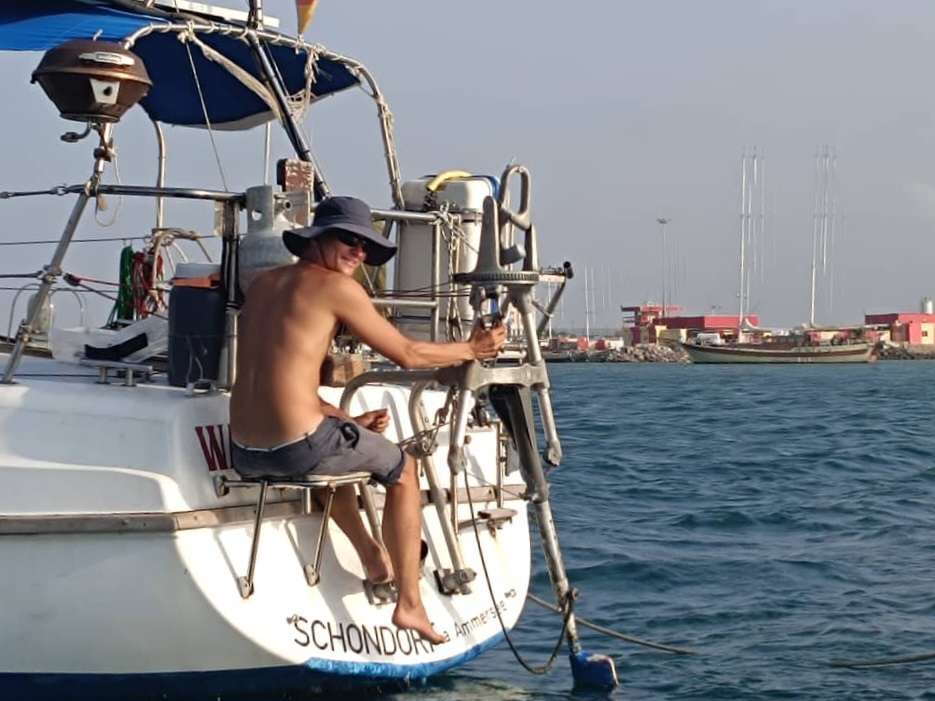
We cast off at sunrise on Sunday. „We“, that’s Paul C. (Big Paul) on SY CORRYVRECKAN 2, Bill and Xixi on SY CAJUCITO and myself. We had joined forces to always sail within sight of each other as a flotilla. That way we could support each other: If one of us was asleep, the others would keep watch. Also, we could discuss assessments with each other over the radio.
We really flew through Bab el Mandeb! 25 – 35 knots from astern and up to 2 knots of current pushed us along at up to 8 knots. Yippieh!!!
Our strategy worked well. While Big Paul kept watch for me, I even managed to sleep for an hour at a time despite my excitement. – Until suddenly, on the second night, there was crashing around us. Or rather: it boomed!
Again and again, the horizon to the south and south-east of us turned orange. It looked like a distant thunderstorm – only more orange. Suddenly, the sound of airplanes could be heard directly above me and only moments later I saw huge fireballs rising into the sky behind us.
I can’t remember what I was thinking. In any case, I started counting: 25! I got to 25 until I felt the shockwaves of the explosions. That meant they were at most nine kilometers away from me! When I heard the plane coming back, I hoped that the next charge wouldn’t be for us.
Hope! Because once again I didn’t know – we didn’t know what had happened. It wasn’t until the next day that we received news from friends and my father: it was a retaliatory strike, an airstrike by the US forces against the Huthi targeting missile bases a shore and a drone ship.
We continued through the Red Sea in the direction of Suez. Sometimes with the wind, sometimes against the wind (this explains the zig-zag courses on my tracker). SY Cajucito left our flotilla for Suakin. Her autopilot went on strike and the two sailors had been steering by hand practically since leaving Djibouti!
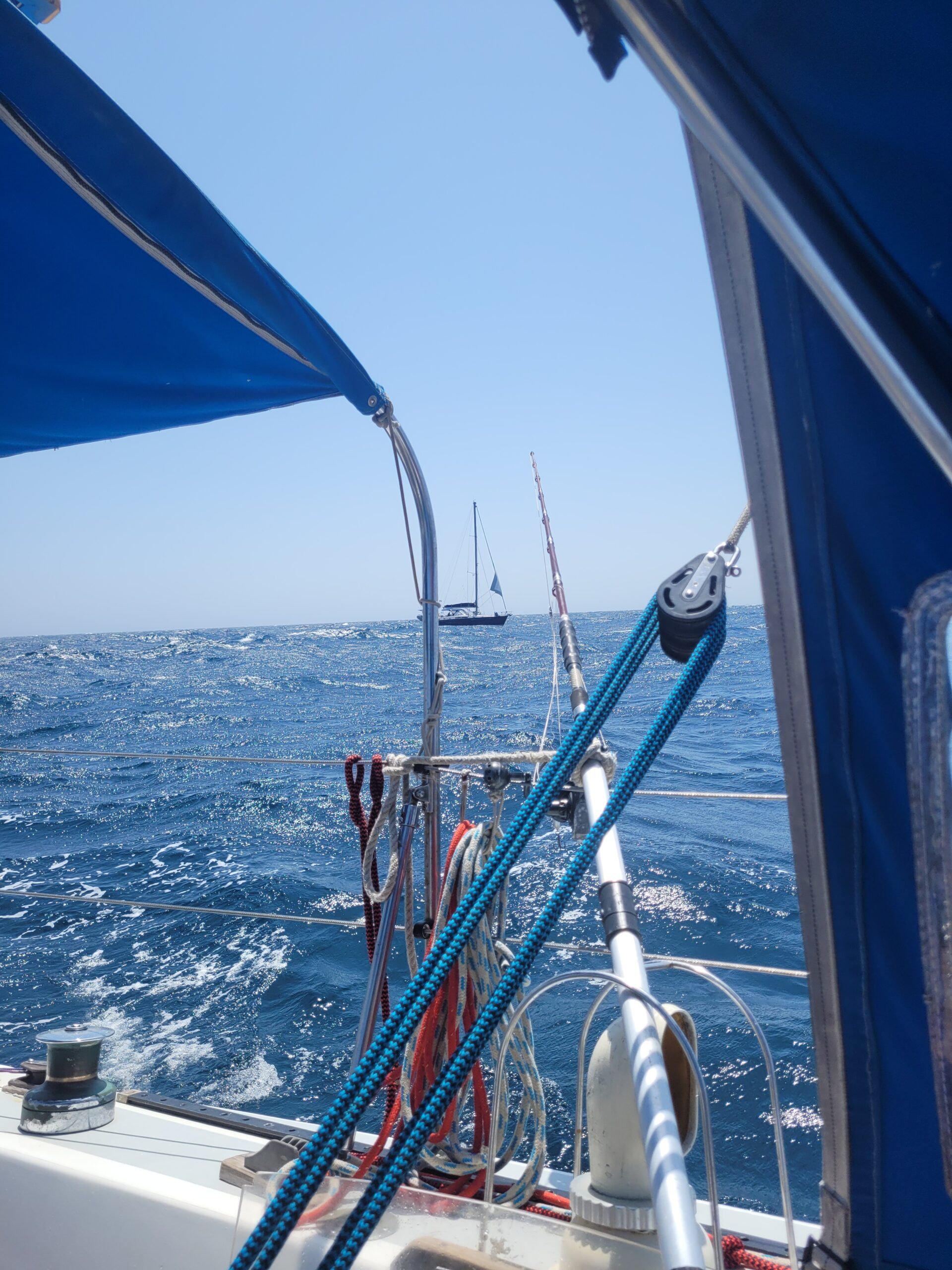
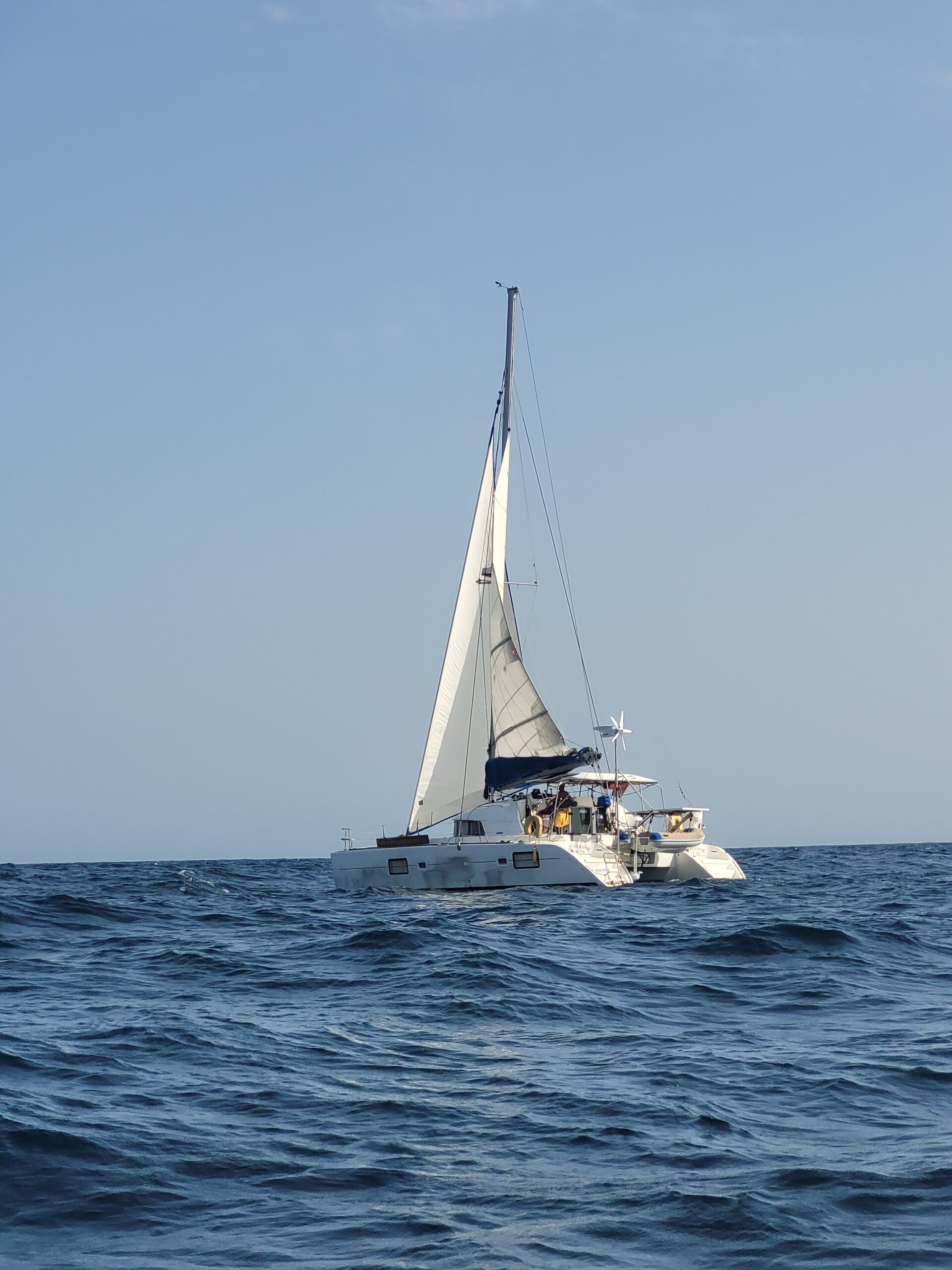
Big Paul and I wanted to sail all the way to Suez without any unnecessary stops. At some point, around the Egyptian border with Sudan, the wind turned against us again and hammered us with over 33 knots. I had set the main in the third reef and the staysail jib. I had already sailed well like this in a storm off Australia.
Although Paul and I were still taking it in turns to keep watch, the weather, the desert cold and the heavy pounding of the boat were really getting to me. Sleeping was hardly possible. It was probably also due to the previous exertions – that night I hallucinated from exhaustion for the first time in my life!
The front held for 10 hours. Then the wind slowly died down again. I gradually opened the reefs until I finally had full sails again. I made short work of Big Paul. Because I was fucked. Completely. Big Paul kept an eye out for me for most of the day. I lay in bed, where I had some sleep to catch up with.
Even as we started our night watch, I got the first round got sleep. I undressed and lay down in my bunk below. The sea was calm. WASA sailed very comfortably, steered by the wind vane, at 4 knots upwind.
Then suddenly there was a knocking on the side of the boat.
Irritated, I rushed outside. It took a second – I thought I was hallucinating again, but the realization came dryly: the mast is broken. Just above the first spreader. The top was dangling in the water, the sails and the forestay were hanging crippled over the sea fence.
Something inside me switched to automatic mode. I went back downstairs, put on my rain trousers, jacket and boots, strapped the lifejacket around my chest, put on my gloves and heaved the tool bag into the cockpit. Then I reached for the handheld radio and alerted Big Paul.
My first thought: „Everything off!“ – my hand reached for the angle grinder.
Then the second thought: „At least try!“ (to save the mast)
I first cut the mainsail from the mast slides and was able to get the first piece out of the pile. The mast was still hanging on by a few cables at the top of the break. I put a rope around the top of the mast (which was now bottom) and cranked it up over the winch, up the side at the stern of the ship; secured the middle with another halyard on the mast stub and then grabbed the machete. I climbed the few meters up the mast and cut the cables with a few powerful blows. The mast immediately sagged and came to a standstill (or lay still?), almost perfectly, just above deck height, in the prepared ropes.
I was then able to pull the bent forestay and sail on board and lash it down – I still don’t know exactly how. Then there were just a few more halyards and shrouds to collect before I could start the engine.
I contacted MSCHOA and my parents by satellite phone, explaining the situation and that I was heading for Port Bernice, a military port 60 nautical miles away, under engine. Despite the exhaustion I felt, I couldn’t sleep. Too much adrenaline?! What’s more, I was now almost invisible: the AIS was also dead without a radio antenna on the mast. Between the waves, I was only emitting a low-quality radar echo and I only had the (luckily recently replaced) position lights on the bow and stern to be recognized by other ships.
I was awake until four. Then I couldn’t remember anything. When I woke up again, the sun had long since risen and the first outlines of the coast were peeling out of the haze. Coffee! And a tin of tuna! And cookies. – Better!
The adrenaline had evaporated and every now and then a fit of sobbing ebbed through my body. When I saw the coastguard ship coming towards me shortly afterwards, I had to scream and howl.
Everything that happened after that is like a hint of a happy ending to the story:
The coast guard sent two ships after me. „Navy Boat 12“, which was the first to get to me about 15 nautical miles from the harbor and from then on guided me through the reefs into the harbor entrance. And „Navy Boat 604“, which joined us a little later, coming from the sea and took me in tow (after briefly clarifying any costs – none) and brought me into the military harbor of Port Bernice before sunset.
„604“ immediately headed back out to sea, but Captain Hossam of Navy Boat 12 and Base Commander Nosir met me at the pier. We talked about what had happened, what I thought I needed to do to continue my journey safely and how we could do it as quickly as possible.
I even got dinner and one of the officers lent me his cell phone so I could use the hotspot to call my parents and friends and to do some research. Then I tried to sleep.
The very next day, just as I was sorting out all the chaos on deck, Nosir came by with good news. He had passed on the problem to the military technicians and, together with his superiors, had found specialists who wanted to come the very next day to carry out an initial repair to the mast. – He told me to measure it right away!
It should be noted that Port Bernice is in the middle of the desert and apart from the military base there is nothing, absolutely nothing! The technicians traveled over 400 km from Safaga. By the time they suddenly arrived in the middle of the night, I had everything ready: Sails, shrouds and halyards had been removed and the two mast sections had been brought ashore with the help of a few additional men.
Then a car parked on the pier and in the headlights of the cart, a welding machine, an angle grinder and two large hammers were unpacked, which were immediately used to start hammering away at the mast. – I panicked for a moment! – „Jesus!?; what are they doing?“ The technicians didn’t speak any English and their approach was, let’s just say, a lot rougher than I would have expected!
But back with the reminder: „We are in the fucking desert! – They will know what they are doing!“
And they did! With bare hammers, they formed a kind of sleeve from a piece of warship floor, which was put around the mast. It was attached to one half, first bolted, then dangled to fit and welded on. The other piece of mast was then inserted, aligned and attached with 2 spot welds. Then again: first bolt, dangle and weld.
After four hours the job was done; within 5 minutes the tools had been collected and the car was ready to leave even before I realized that we are done. I paid the agreed $200, thanked them and apologized once again to the two metalworkers, quite ashamed of my first reaction! Nosir translated and I think they understood me…
A day passed while I tried to improvise a rig from my remaining shrouds and the very next day a crane rolled up to help us put the mast back up. I was able to negotiate the remaining day and another day to tighten the shrouds, patch the sails and get WASA shipshape.
Then, I realized, it was time to let the military base be a military base again, to say thank you another thousand times and to say goodbye. I was and still am very touched by the warmth and helpfulness of everyone involved! Not only did they help me with the repairs, but I was also able to use the internet for a few hours every day, I got breakfast and dinner every day and was able to have a laugh with some of the guys – even if we didn’t always understand each other (linguistically).
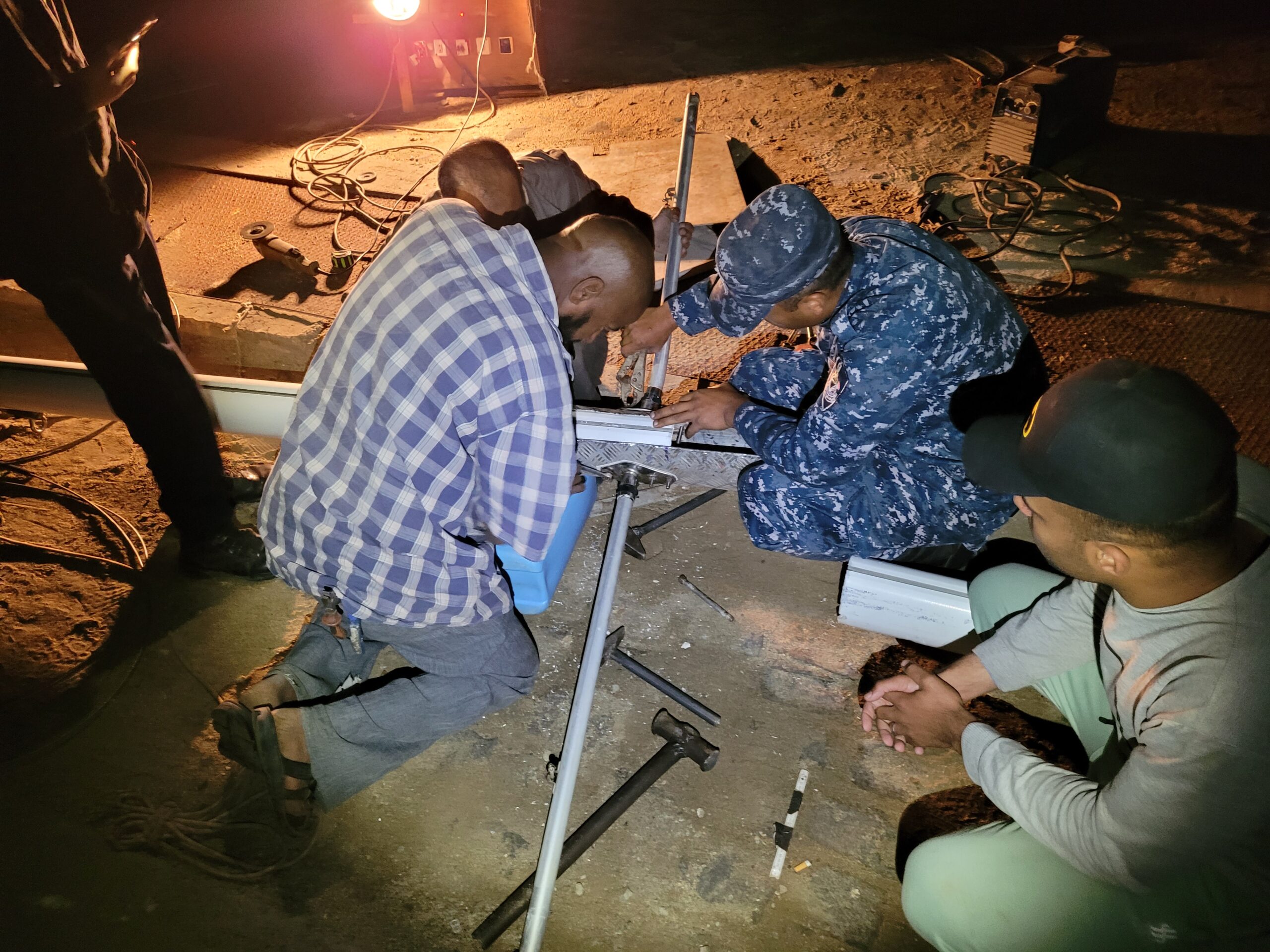
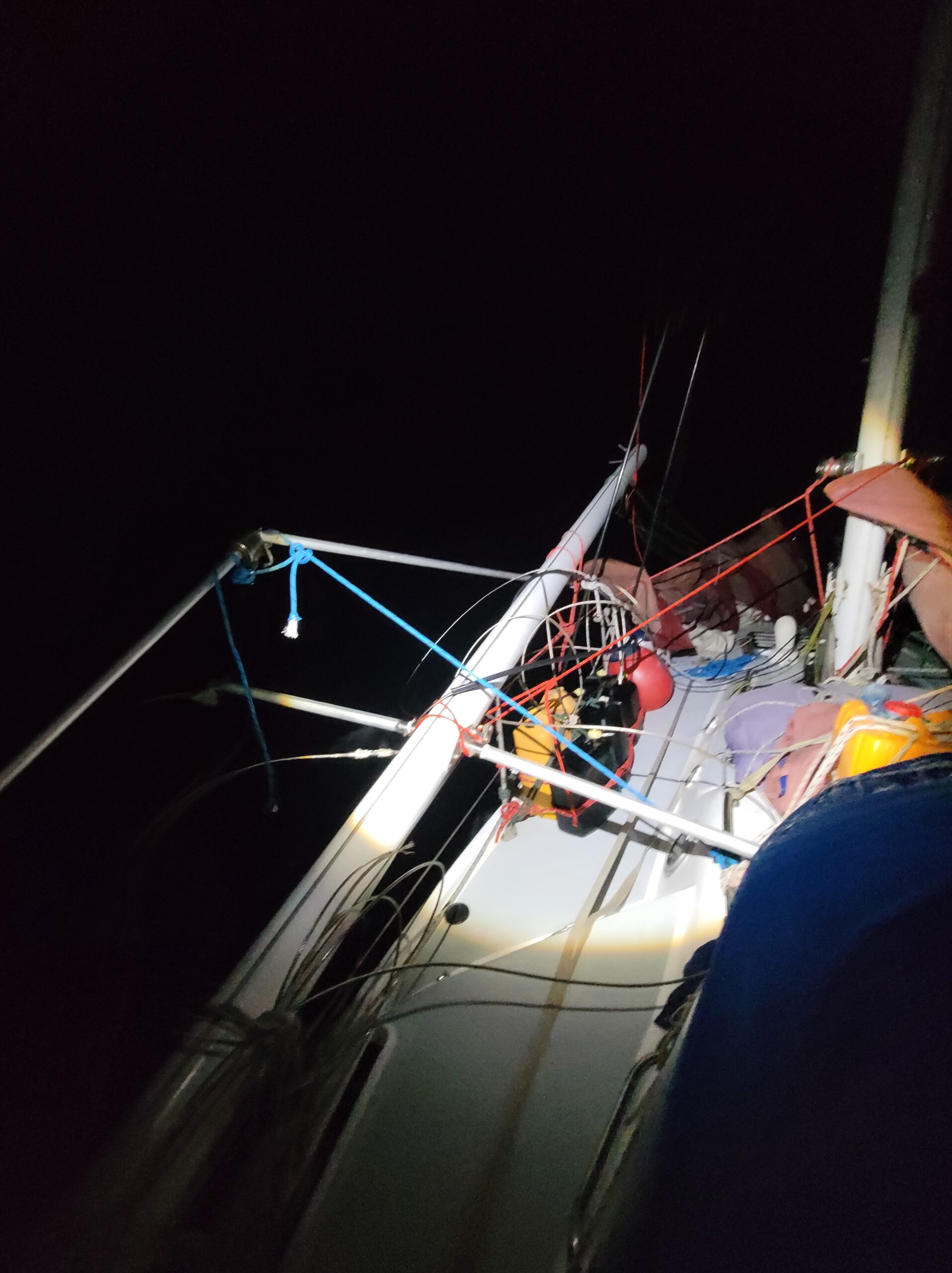
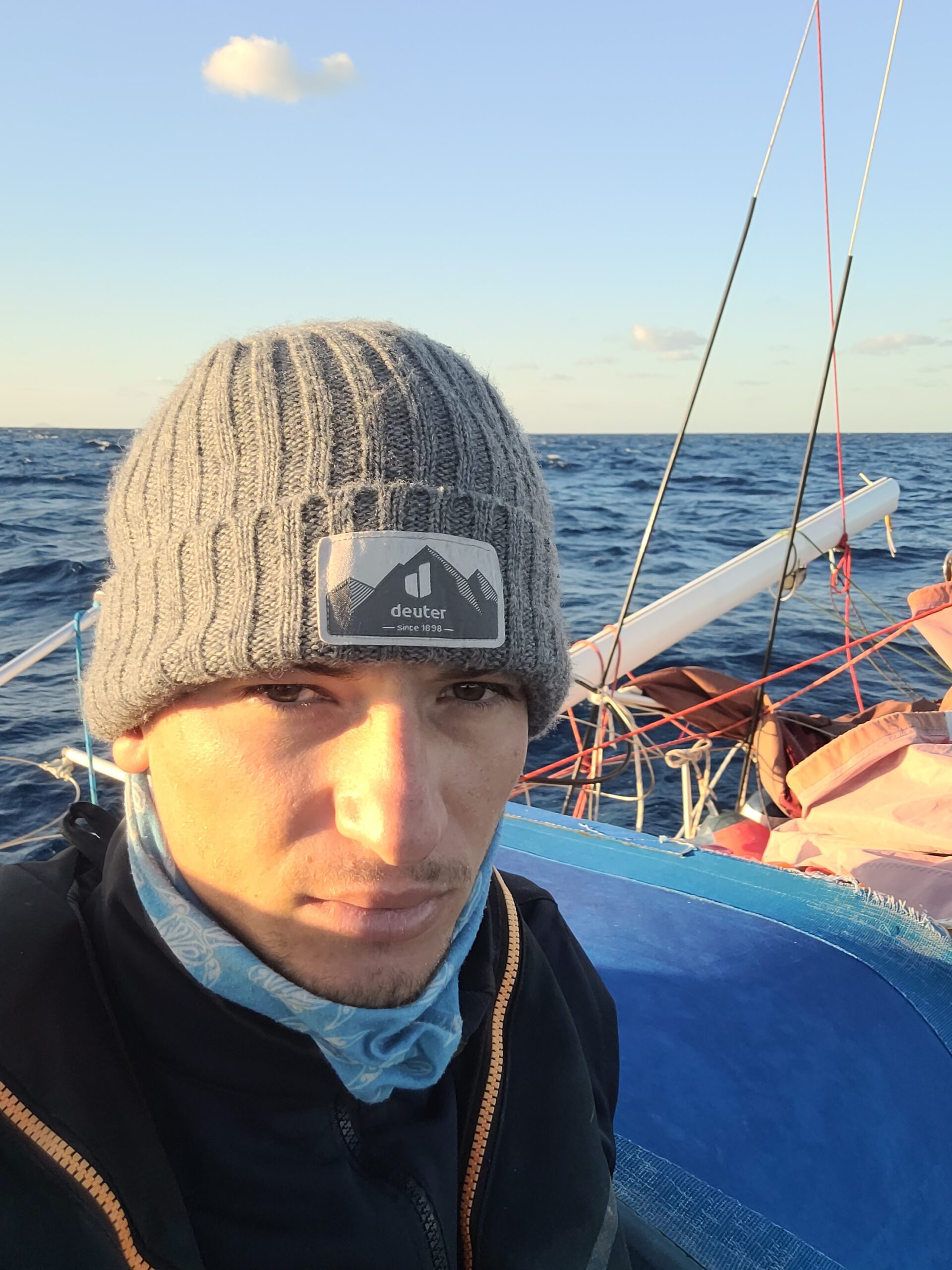
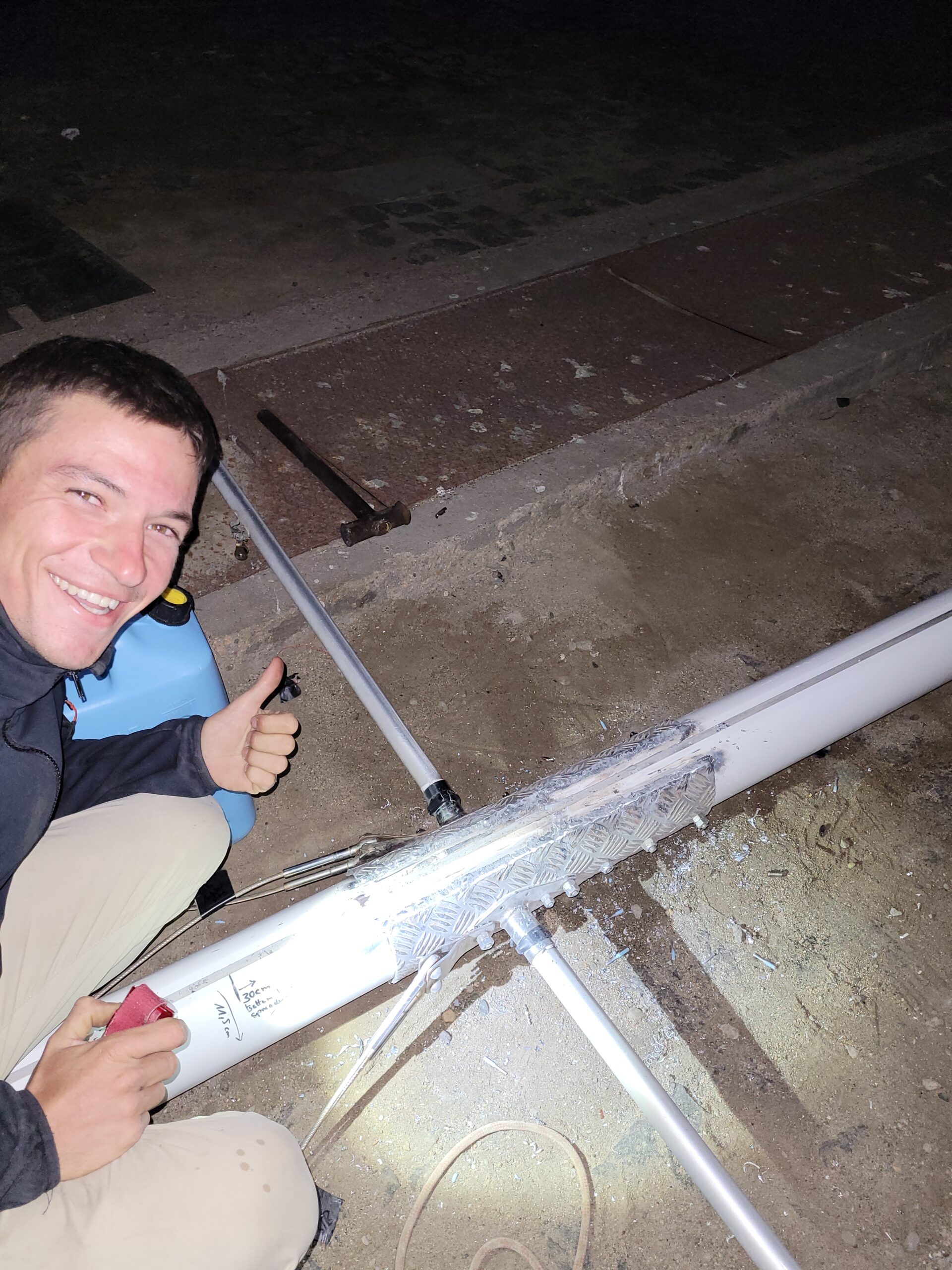
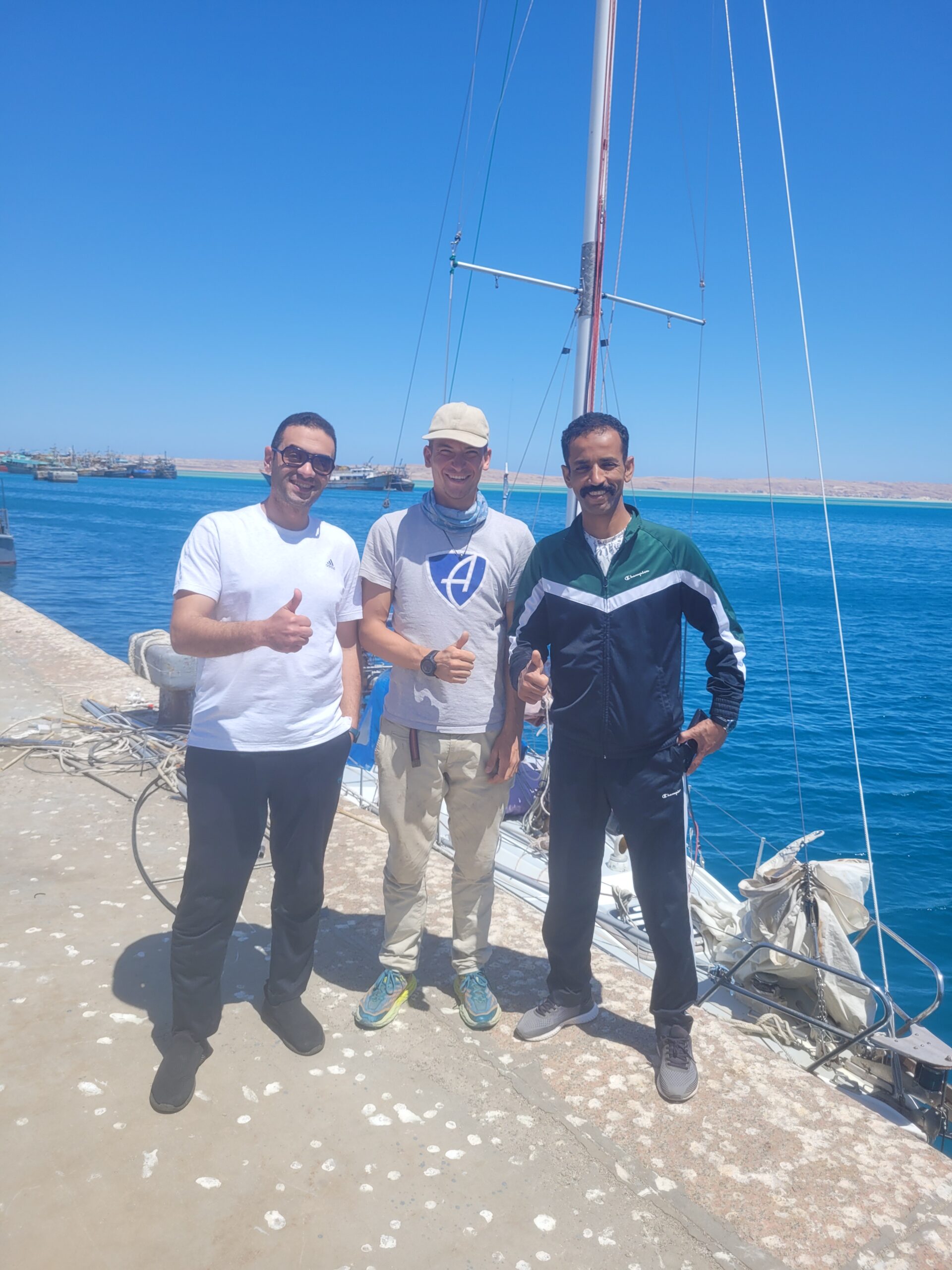
I also received incredible backing and support from other people:
The news about my accident spread like wildfire and I received an incredible number of kind and encouraging messages from friends, people I know and even strangers!
Many people donated to my tip box to help me afford the subsequent repair or replacement of the mast (a 100% master plan has not yet been drawn up). A friend, Zander, who experienced mast breakage with his wife Yvette on their boat in the Pacific, set up a Gofund.me page to support me. – A considerable sum has already been raised, and the goal is to collect 5000$ to make the repairs in Cyprus possible.
And I can’t say much more than „Thank you!“. A thousand „thank you!“ to everyone who supports me here in any way. Without your help, I would not be able to sail my dream to the end!
I am currently working my way towards my next destination, the Suez Canal, in small, cautious hops. From there I would like to sail to Cyprus/Limasol in a favorable weather window, where I am already in contact with a boatyard to carry out the final repair!
I’ll keep you posted!
